Introduction
The modern awareness with global climate change and environmental protection has shifted the tourism industry to align with the ecotourism conceptual framework while the economist identified it as a most strapping toll for community based sustainable development for the lees developed or developing countries. The major limitation of the economic development of the third world countries are lack of capital and skilled human resource for investment and lower purchase power of the mass people due to unemployment. It has been argued that ecotourism could facilitate the third world countries with a major source of earning foreign currencies from ecotourism and involving local communities with those ecotourism projects and attracting international tourist with nature based approach. This thesis has been deliberated to examine to what extend such economic policy of developing countries could gain success in context of Malaysia and the grassroots level stakeholders of Malaysia has been engaged with ecotourism projects and to what extent they are successful in their environmental management.
This thesis would examine the ecotourism segment of the tourism industry with the aim to explore and investigate how this framework would contribute the third world countries with accelerated income from tourism industry without any negative impact on the local environment, culture and heritage and it would also investigate the position of Malaysia as a case study in this regards.
Background of the problem
Neth (2008) has concentrated his analytical views on the sustainable development of community-based ecotourism in third world countries like Cambodia and explored that implication of excellence in ecotourism has a great prospect in this region but there are huge gaps on the theoretical explanation and real life scenario. With tremendous scholarly research, work and wide-ranging evaluation of available literatures he pointed out that tourism has diversified into in the close proximity of natural resources along with unharmed rural areas those are not yet touched with anthropogenic impact, local cultures sustained with long tradition would be in risk of environmental degradation. Moreover, there are enough possibilities of imposing new rules and regulations for environmental management those may seriously influence the behavior of local incumbents and there is chance for not to cope adequately with the adopted system by the local communities and may argue as inconsistent.
Weaver (2001) pointed out that even if ecotourism addressed for long-term nature based tourism for at lest last three decades inside the confined areas, in practically there is nothing new within the formulation and practice though the approach is differentiated and can be argued it as a diversified strategy of conventional tourism. Due to long practice, the conventional tourism industry has experienced that the environmental degradation would reduce their future profitability and credibility by reducing the market size with careful tourists segment. Thus, the conventional tourism companies have aligned with ecotourism even if without enhancing their value chain, which evidenced as contradictory reality of the core essences of ecotourism. In addition, the global climate change and environmental management strongly argue that engagement of tourism with any vulnerable sites and destinations would hamper the local environmental sustainability with critical threats to the integrity of those sites along with the confined communities and stakeholders.
Bagul (2009) has conducted a landmark research with the ecotourism site of Sabah, Malaysia, identified how the local communities have integrated with the project, and offered the opportunities to maximizing economic benefits but not identified to what extent the largest ecotourism site of Malaysia has been threaten the ecosystem or how the third world countries could beneficial with such project.
There is enough evidence that many traditional tourism entries are becoming involved with practice of ecotourism and offering their service without employing any value chain or misusing land resources in the name of ecotourism in Malaysia. Under this era of environmental awareness and recent recessional economy, ecotourism segment concept would principally significant for the emerging economy as route to recovery their economic growth to an improved level. The local legislation of Malaysia on ecotourism segment has flourished new dreams for the Malaysian business communities that it will contribute with proper assistance, but surge of the ecosystem from degradation by human activity though the operation may generate new challenge.
There are huge studies on ecotourism segment concept, but there is enough gap in the area of which variables of ecotourism segment concept would explain the differences in performance with elevated scale of operations, how ecotourism segment concept have substantially with better use of natural resources, sustaining, and enable the tourism industry to achieve extended economics of scale. To address and identify these gaps, it is rational to have an elevated study on ‘to what extent ecotourism could accelerate the economic growth of third world countries’.
Research Aim and Objectives
Raufflet, Berranger & Gouin (2008) argued that the raising biodiversity-linked business model has generated a common trend in all sectors of business to add eco, bio, or organic to demonstrate their awareness to the environmental degradation, those are some time just propaganda rather than real concern to the nature. Modern business corporations including multinationals and NGOs also address for fair trade involving local communities along with the profit sharing even social ownership, which is contradictory to the capitalist views of society. Thus, it is essential to scrutinize to what aspect the ecotourism is capable to encourage environmental sustainability and how it contribute to the economic growth of the third world counties. The main objective of this study is to examine the performance of ecotourism segment concept in respect of Malaysia and to understand how this segment of tourism industry has contributed the Malaysian tourism companies to gain elevated profitability and raised GDP with the impact on the existing environment of the country.
Research Questions
This thesis has intended to response the following research questions to support the topic area with proper evidence from the Malaysian tourism industry, the main objective of this research is to analyze the implication and effectiveness of ecotourism and to suggest Malaysian experience for the third world countries to diminish the financial distress rooted by third world countries. This paper would raise four research questions and these are –
- To what extend theoretical framework of ecotourism relates with the core essence of tourism industry.
- How does the ecotourism contributes to the community based economic activities and sustainable economic growth of third world countries?
- To what extend Malaysia tourism has aligned with ecotourism?
- What are the economic indicators of ecotourism contributed by the in Malaysia that can assist third world to implement their ecotourism practice?
Relevant Literature Review
Theoretical Framework of Eco-tourism
According to Regis (2004), ecotourism is a drive towards resolute tour to nature-based locations to appreciate the traditions and ecological chronology, bothering about not changing veracity of the bionetwork, whilst generating economic prospects; in addition, the conceptual framework behind the background of the terminology comprises an appraisal process, where ecotourism standards and its corresponding management guidelines, and a communication plan. The framework has set up by considering the standards put forward by Jeffries (1997) on biodiversity and eco-conservation besides of some other popular researchers specializing on issues of ecological safeguard, protection of rainforests and mangrove forests, together with the expansion of communities and human societies near this natural sites. Additionally, the results achieved by Regis (2004) from the ecological tourism project over 2 different towns in Sorsogon, Philippines were even more helpful to strengthen and enhance these courses of action regarding ecological conservation, and to sort out the way in which a strong set of principles would be able to better conserve the atmospheric charm. The table below shows the major features of ecotourism:
- Ecological tourism comprises tour to comparatively uninterrupted and peaceful place, which are full of atmospheric beauty natural; moreover, this may also comprise archeological places
- Ecological tourism concentrates on gathering knowledge about the value of local cultures, traditions, and natural sites
- The potential advantages of ecological tourism in terms of economic and living standards of the neighboring societies is huge; for this reason, many governments want to undertake development projects and campaigns to increase the tourist attractions
- Ecological tourists searches for observing the exceptional sort of lives, magnificent sceneries, far-fetched natural beauty, together with salient way of living
- The most essential fact underlying the morals of such tourists is that they never try to diminish or harm reserves of nature and assists to keep up and preserve the atmosphere by facilitating to lessen spoils to the surroundings, which may be a result of unplanned travels by reckless people
- The notion has based on the idea that the tourists who hold this concept in mind should show gratification and admiration about neighboring traditions, customs, and so on.
Community based approach and Social ownership/ Stakeholders
It is important to note that when it comes to the concept of ecotourism and the acceleration of the economic growth of third world countries, Amartya Sen’s concept of human development and empowerment becomes clearly apparent. Ecotourism accelerates economic development and gross domestic product per capita, but this becomes possible only when the local community near the nature induced ecotourism spot become involved with the project through employment opportunities, for example.
Previously, economic development was measured in terms of GDP per capita, food security in terms of food availability, and poverty in terms of income-deprivation; importance was placed on economic-efficiency with no clear function of fundamental-freedoms, individual agency, and human rights; conversely, Amartya Sen’s work identified that market outcomes and government actions have to judge in terms of valuable human ends. His key idea remained with the fact that the development and freedom of human, together with improvement of their skills, knowledge, and most importantly, encouragement towards their empowerment can be the best evaluation through which economic development can be measured. In other words, development of the human side of the economy can best develop the “economy” (Prendergast, 2004). The following table shows noble laureate Amartya Sen’s concept in contrast to the past ones:
Figure 1: Comparison of past perceptions and Amartya Sen’s perceptions. Source: Self generated from ODI (2001)
According to WWF (2001), connecting the neighborhood is a perilously imperative and multifarious matter for flourishing community-based ecotourism, because prospects and solutions may differ significantly in diverse regions and among communities; however, a vital standard is to seek to work with community structures, although these can generate challenges; moreover, this can help to recognize potential leaders and citizens with drive. The key purpose behind this should be to attain extensive and evenhanded advantages all through the neighboring society; concerns of gender may also be imperative and ecotourism can provide good opportunities for women; in addition, community based ecotourism needs an understanding, and where feasible, an intensification of the lawful privileges and tasks of the neighborhood over territory, possessions, and advancements. There should be a significant amount of concentration, provided to uphold the rights of the neighboring communities, based on the ground that they have legal rights over the land and they are able to utilize this right, helping them to earn substantial income from tourism-sector; specifically, there should be participation in land use, planning, and development control over private property. Substitute for communal involvement with organization may consist of private tourism firms recruiting neighboring populace; even though this designates a helpful structure of employment, it is extremely imperative to safeguard people from low wage-rates and adverse circumstances and to make sure that schooling has provided to them; moreover, neighboring folks could selling their produced-items to the ecological tourists traveling around.
Correlation between Ecotourism and Traditional Tourism
Weaver (2001) found out a number of reciprocally advantageous correlations involving ecological tourism, mass-tourism, and particularly safeguarded nature based regions (which can be great traveler attraction in terms of ecotourism):
Figure 2: Correlation between Ecotourism and Traditional Tourism. Source: Self generated from Weaver (2001)
Since ecotourism is comparatively compelling that could engender considerable profits, it is possible that governments consider this more critically; with assistance from the part of public-sector and other-sectors of mass tourism market, ecotourism could contend with those trying to abuse the usual atmosphere through logging/mining; moreover, it benefits traditional tourism and reinforces it through diversification, by presenting ecological attractions.
Innovation and Product development of Ecotourism
According to Denman (2002), an immense disparity exists in understanding what composes an ecotourism product; for ecotourism, Americas and Africa focuses on forests and wilds, whereas Asia focuses on cultural-dimension and Europe on rural-tourism sceneries created by human; nevertheless, in one word, ecotourism-product should provide travelers with genuine perceptive of ecological and traditional legacy, and engross by benefiting neighboring inhabitants. However, in all these continents, the intention for the improvement of ecotourism products has connected with long-term economic advancement aims; under certain conditions, the causal intention could be to assist eco-conservation, by engendering additional nature based reserves or offering a neighboring economic base; furthermore, the main inspiration could be to expand economy and tourism industry, or handling rustic poverty. Many ecotourism products have expanded for a huge number of grounds; however, at every instance, the philosophy following triumphant product enhancement and advertising are analogous; even though there could be some resemblances in purposes and standards, the preliminary end and specific state of affairs of apiece plan might be significantly dissimilar. Existing points of travels, intrinsically pleasant appearance of the specific vicinity, convenience and transportation, environmental compassion, neighboring expertise support, and society constitution and ambitions would differ; these differences exist within all regions as well as between them; consequently, each separate scheme requires to be extremely cautiously evaluates and designed.
Ecotourism Policy (Regulation) and practice in Global Aspect
Tourism, the leading industry in globe, contributes to one-third of all global trade, and many observe tourism as accelerator for economic improvement; according to WTO, nearly 625m global tourists expended $444.7b in tour related costs without airfare in 1998; moreover, Ecotourism Society estimated that over next two decades, arrivals will boost by 4.3% and receipts will climb by 6.7% yearly. Rubinstein et al (2005) stated that a boost in affluence, the amount of retired people with earnings to move, and infrastructural advancements have contributed significantly in expansion of tourism-industry in late 20th-century; within the quickly expanding touring market, the most rising segment is ecotourism, which is mounting between 2.5 and 7 times quicker than the rest of the tourism sector. As per WTO’s report, in 1998, global explorers expended 48b US Dollars on ecological tours illustrating about 10% of all worldwide touring expenses; additionally, in United States, 4 to 6m people trek abroad for environment associated tours per annum; Ecotourism Society stated that 30% of all sightseers nowadays are “ecological-tourists”, signifying that this industry-sector is engendering about US Dollars 145b. Costa Rica has been extensively familiar as an ideal for facilitating a background for ecotourism-policy because of its communications progress, public and private partaking, and open market economy; the government passed a tourism encouragement regulation providing developers of lodges, car-rental business, and travel businesses a twelve-year cessation on taxation in turn for speculation in the nation’s traveling market. In recent times, the country’s tourism ministry established the first government certified tourism official recognition guidelines; in addition, other nations like Brazil, Argentina, Belize, and Indonesia have provided capital incentives in this sector; though the monetary necessities for ecological traveling plans are comparable to other moneymaking schemes, the possible return of ecological traveling are superior from many other investment opportunities.
Community involvement and employment opportunity
One of the most integral conditions of ecotourism is that it must ensure various levels of community involvement. This kind of involvement generally depends on two community criteria. The first one indicates the group of people who live on the revenue area while the other indicates the group of people who reside within the jungle areas. Thus, community involvement can take a number of forms regarding tokenism, informing, collaborating, consulting, and ownership. Tokenism is the practice of engaging community partners for different tasks, like- tour guiding or driving etc. They can also act the role of information suppliers about the ecotourism site and its specialties. Through the consulting service, they can influence the decision making process of the tourists while collaboration is the process of acting as copartners for making decisions and enjoying direct advantages of ecotourism. Finally, through ownership, community members become the owners of businesses where they take the entire decisions regarding the tempo, pattern, and partner of such businesses (EQUATIONS, 2010).
In many developing countries regarding India, villagers as community members own small enterprises to sell necessary commodities and souvenirs to the tourists. Some also offer lodging and food to them. In some areas, local youths act as guides for which many public as well as private tourist agencies hire them frequently. Today, many local people and aboriginals are getting aware about not only environmental but also cultural heritage. Regarding conservations, they tend to plant more trees and inform the official forestry department about injured animals and forest fires. Because of such kind of involvement, the practice of woodcutting, poaching, and theft has been drastically lessened in Choti Haldwani Tourist Park. Children and women are also contributing in conservation programs throughout their active involvement in making and selling souvenirs. Therefore, these forms of involvement are enhancing employment opportunities for the local people as tourism workforce, transport drivers, and tour guides etc. Some other employment generation options are heritage trails, home stays, souvenir shops, and information kiosks. Since different communities occupy specialized knowledge and expertise in different local arts and handicrafts, such expertise can be used for their self- dependence.
Globalization and market demand
There are various types of ecotourism products towards, which large number tourists from remote corners of the world have keen interests. These products are the blended functions, resources and services involving hiking, bird- watching, diving, mountaineering, and photo shooting etc. (Srinivas, 2011). Since the world is turning to be a global village, travelers from various countries are now acknowledged about the natural beauty and significance of those ecotourism products located at different developing nations by newspapers, magazines, internet, and TV channel features. Therefore, it is clear that ecotourism product is the combination of visible ingredients and expected experience towards which global customers are attracted in terms of generating value (Boerner, 2006). Such as-

Globalization links socio- economic, political and geographic areas as a chain which motivates the development in tourist functions across such areas. It offers the means of easy communication and information exchange among people, which act as one of the most accelerating issues for enhanced ecotourism demand. Additionally, globalization makes it possible for the quick access of information through internet. As a result, travelers can more realistically idealize the enjoyment and experience from a potential visit of a tourist spot. It is also contributing in educating people about the versatile culture as well as influencing them to have a visit around different parts of the world. Finally, globalization characterizes advanced and speedy transportation system that ensures safety and easiness in travelling. Therefore, all those strategies are helpful in developing widespread demand of ecotourism products (Herdiyanto, 2008).
Environmental management cost and earning
From environmental management point- of- view, there are several earnings of ecotourism. Ecotourism entails the full potential for offering the motivations for conservations of natural regions. It delivers monetary and material resources for natural conservation and protection against environmental distortion and biodiversity development via gene programs. At the same time, proper environmental management enhances environmental consciousness and moral behaviors among the tourists. It has been noticed that mega eco- tourist companies are yielding more advantages by practicing this management through scale economies. Since they are capable to implement environmentally friendly advanced technology, they can successfully arrange tourism programs without causing any natural loss. They also frequently engage environmental specialists for perfectly managing various eco- tours (SATT, 2011).
Long- terms sustainability and GDP contribution
Sustainable development is one of the most prime objectives of eco- tourism that can yield huge economic benefits in terms of having a great GDP contribution. Various government and private eco- tour organizations arrange eco- lodges and camps with a vision of maintaining a sustainable development. It is the practice of keeping a balance between nature protection and business promotion in order to keep both the natural environment and tourism market sound and healthy for long- run. Therefore, sustainable development alerts that the ecotourism practices need to be scientifically sustainable for all of its products and functions at each phase of planning, management, and growth. Here, all the elements of the nature and culture are used at sustainable and suitable level so that potential financial opportunities can be created for both the tourists and community participants by ensuring an overall benefit for all the associated parties (Srinivas, 2011).
There are some criteria through which such sustainability is practiced for a broader purpose of GPD contribution (Chaynee, 2005) and these are authorization and regulation, education program, neighborhood control and so on.
Global market statistics and prospect for third world
Today, ecotourism is being treated as the mean to “Travel to enjoy and appreciate nature” which reflects a growing demand of that aspect of tourism. According to one report, public demand for tourism is increasing by 10%- 15% annually while demand for ecotourism is increasing about 10%- 30% (Herdiyanto, 2008). According to WTO, international tourists make 20% of their total travel only for this purpose while an extended growth rate is 4.1% through 2020 (TIEC, 2000). Based on such information, the global market ecotourism expenditure can be shown as following

It is also assumed that those countries can generate total revenue of $2- $12 billion annually. For example, Kenya is earning about $1 billion from scuba diving while Amboseli National Park is assumed to generate 20%- 29% of internal return. In 2006, international ecotourism growth rate was 4.5% while Africa individually gained 8.1% of growth. Tanzania and Kenya attract 75% tourists to show their wildlife. Through such ways, third world countries have a greater prospect for ecotourism that can also facilitate them for becoming more economically independent in terms of employment, social and cultural development, environmental control, and long- term sustainability (Varty, 2011).
Introduction of Eco-tourism in Malaysia
Daud (2000) denoted that before discovering Malaysian ecotourism profile one should to have familiarity on exclusive geographical and environmental attributes of the country. Geographically, Malaysia covers two segments of Borneo Island namely Peninsula and East Malaysia with an aggregate area of 329,758 km square. All over the year Malaysian climate holds warm as well as moisture and compare to the global botanical diversity the country consists most plenty and then able to endowing exclusive natural attractions. Conversely, Malaysia is a multi racial1 nation that consists of 22.0 million population thus undoubtedly its an unique dimension for Malaysia that encompasses three most significant civilizations along with culture of Asian region with fascinating land sights as well as attractions. Considering all these facts, both tourism and ecotourism industry of Malaysia is now considered as major revenue source of the country following 46.0 % of aggregate GDP. In short, an introduction of ecotourism in Malaysia is a growing sector that accomplishes in gaining significant economic achievement by gathering RM213.40 billion foreign currencies in terms of approximate 7.90 million foreign tourists visit every year. Here, point should to notice that major portion of the foreign tourists are from neighbor geography like Asian and Pacific countries3 but recent government policies and strategies hope to a significant increase of tourist numbers from Middle Eastern Gulf countries, other Asian countries like India, Western nations including USA and Australia to explore their tremendous potentiality developing ecotourism industry. Alternatively4, an introduction of Malaysian ecotourism should to structure historical development of ecotourism in Malaysia that revealed before 1970 Malaysia was not regard tourism and ecotourism significant economic source and consequently, during 1972 the TDC5 established featuring responsibilities of acting developing authority. However, till end of 1970s decade, ecotourism in Malaysia got low priority with limited financial allocations that generate obstacles performing catalytic role effectively. On another hand, during that time compare to neighbor countries ecotourism in Malaysia could not build reputation as mass ecotourism destination. Following the malfunction, like other global tourist industry Malaysian government undertook numerous significant stimulating initiatives developing ecotourism industry since 1990. Major of them are involved as bellow
- Establishment of the MCT6 in 1990 and later amended as the MCAT7 involving institutional framework planning, coordination as well as regulation of effective ecotourism and in addition, for the first time of Malaysian history ecotourism is recognized as a part of economic source.
- Considering significant premises of Tourism Industry Act of 1992 along with Malaysia Tourism Promotion Board Act of 1992 the MCAT assembled role of ecotourism formulation, approaches of policy implementation, licensing as well as enforcement issues of the ecotourism industry. Additionally, the TOC commenced as MTPB8 or Tourism Malaysia assign to concentrating on marketing as well as promotion of ecotourism.
- The ecotourism sector was later taken into account Investment Incentives Act (IIA) revised during 1986 in order to confer additional stimulating ecotourism investment incorporating i) pioneer status for investment tax allowances, ii) allowances for industrial building, iii) promoting tax exemption in case of large foreign–group tours.
- Encouraging SMEs9 development federal government of Malaysia approved RM 120.0 million exclusive funds for ecotourism in 1990.
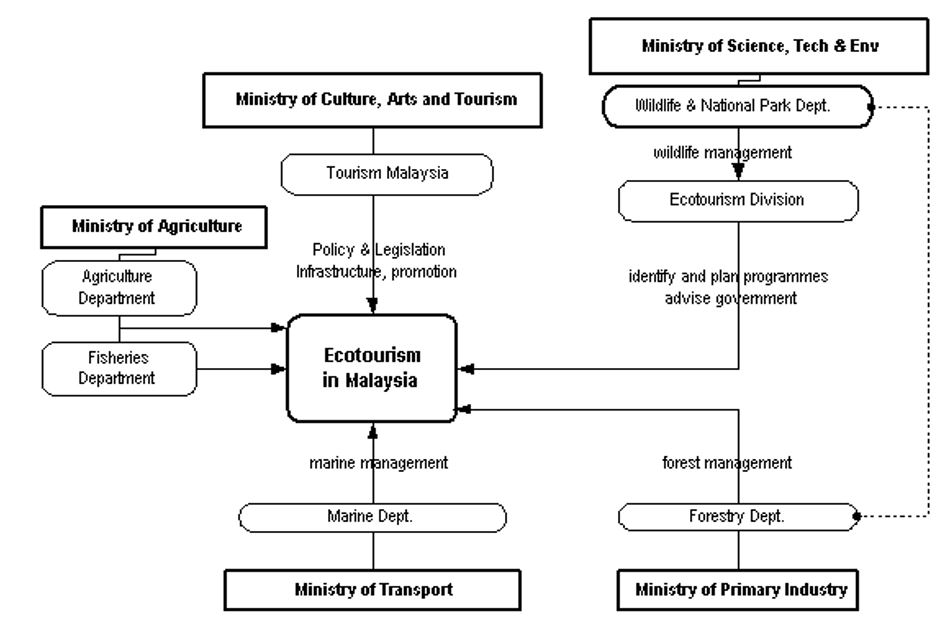
Malaysian Legislation for Ecotourism to Develop Economy
Malaysian Wetland Working Group and The Commissioner of Law Revision (2006) demonstrated that, geographically Malaysia is split into two broader from a) the West Malaysia or Peninsular Malaysia and b) East Malaysia that covered entire states of the Sabah and Sarawak located in northern Borneo. On another hand, Malaysian geography has significantly featured with the wetland and the wetlands of Malaysia are involved with ten diversified categories10. Considering rich environmental resources Malaysian federal legislation for ecotourism segmented through several divisions where each area is set aside for protecting respective number of varied laws. Considering applicable legislation protection level would have achieved different parameter but should involved agencies to responsible for managerial implication where as protected areas must treat under Federal Jurisdiction of Malaysia. Meanwhile, Malaysian wetlands policy is recommended by the respective Malaysian Wetland Working Group (1986) but still now not free from drawn up and hence, most of the land matters be controlled by the State Decision Making Bodies and in addition, there have a series of diverse legislation concerning wetland as well as protected areas in different States (MWWG, 1988). On another hand, Malaysian Constitution has reserved rights over the State’s entire land matters towards the respective State Government. Following is the description of significant Federal Acts concerning ecotourism,
- Local Government Act 1976 and Environmental Quality Act 1974: under local authorities with an intensified authoritative power these Acts are establish with an attachment of Parts VII and XII to managing public places as well as parks. Authoritative powers of the Acts are responsible for creating small ranging protecting areas of natural habitat and aware on managing parks intensively. Alternatively, Town and Country Planning Act 1976 are specialized to recognizing imperative ingredients of land use where the Act allocates certain powers at respective State along with local levels.
- National Forestry Act 1984: It is available for respective State Director of Forests along with an approval of the State Authority to classify each permanent reserved forest that involved with respective classifications to responsible for protecting wildlife habitat11 though these level of classification do not have authority to offering permanent protection of wildlife as per Forest Reserves offer on scale of 1–712. In case of commercial forests until now areas do not log devoid of State authority but would be selectively logged under license where as Bird Sanctuaries are should to gazette under legislation that already replaced during 1963.
- The National Parks Act 1980 (Amended during 1983):- It defines the establishment ass well as control of Malaysian National Parks which has significantly attached with Protection of Wildlife Act-1972 (Amended during 1976) but can be protected in accordance with the Forest Ordinance 1954 where Wildlife Sanctuaries should to gazette according to Wild Life Protection Ordinance 1958 (Cap.128) and respective amendments. Point should to note that Protection of Wildlife Act is born through consolidation of Malaysian Federal laws with regard to wildlife protection in the Peninsular Malaysia attached with the provisions those represent legislations for protecting life cycle of wild fauna along with its habitat. Moreover, these Acts also provided protecting for managing strict nature Wildlife Reserves and Wildlife Sanctuaries establishment and these allow licensed hunting as well as free from habitat protection special provision but of course it should to sizeable that Federal Government has played central role of controlling over creation, alteration along with extinction of the Wildlife Reserves and Wildlife Sanctuaries lies.
- Fisheries Act 1985: the Fisheries Act is highly admired with Water conservation legislation of Malaysia that attached with the Federal Land Conservation Ordinance 1960 to keep varieties and longevity of fishes. More specifically, managing water resources in the diverse States of Malaysia will should to comply in accordance with the planned National Water Resource Planning and Development Act country wide along with WWF Malaysia and State Planning Unit of Sarawak 1985 and Bennett 1986. As a final point, water conservation legislation has alternatively covered through the Federal Land Conservation Ordinance 1960.
- Sabah and Sarawak: Sabah and Sarawak two key ecotourism ingredient in Malaysia but their managerial implications should not follow The National Parks Act 1980 (Amended during 1983) and this provision is also considerable for three States Parks namely, Kelantan, Pahang and Terengganu which three in aggregate form fall under the constitute of Taman Negara.
- The Natural Resources Ordinance 1949: Natural Resources Ordinance as well as its following amendments consists with the Natural Resources Board that directly fall under entire directions responsible to conservation Sarawak’s natural resources but at present earnestly followed WWF Malaysia and the State Planning Unit of Sarawak 1985.
Ecotourism Policy in Malaysia
In general, federal government of Malaysia integrated ecotourism policy denoting as the National Ecotourism Plan (NEP) or five years long time plan providing strategies of achievement approaches for specialized national ecotourism objectives. Alternatively, NEP committed to contributing as well as producing greater distinctive Malaysian tourism and ecotourism image. Moreover, it should to identify and make availability of local inhabitants’ direct involvement, advance training programs, cooperation between interagency and inter–sectoral entities and finally, most significantly, foster awareness on environmental protection as well as preservation. The NEP has taken into account a set of imperative ingredients as bellow.13
- Adopt and emphasize on a comprehensive definition of ecotourism and promote as well
- Adopt and emphasize on a comprehensive ecotourism policy for developing the industry.
- Take appropriate action for an effective legal change in favor of implementing ecotourism plan with Establishment of both monitoring and appraisal program of national ecotourism;
- Restructure as well as strengthen TIC (Tourism Implementation Committee) prioritizing eco as well as agro industry.
The NEP in Malaysia has currently involved taking action of site plan and management incorporating following issues
- For effective ecotourism development, establish suitable planning procedures.
- Effective ecotourism should to involve with establishing application procedures.
- Gradually elaborating development along with managerial strategies for shining national ecotourism areas;
- Emphasize on countrywide ecotourism areas for an expansion as well as deliver enhance management systems.
- Execution of ecotourism guidelines;
- Structuring a set of national ecotourism pilot projects;
- Key concentration on additional ecotourism products locate at Taman Negara as well as other sites.
- Structure and promoting most consistent marketing strategies;
- Accurate assessment as well as promoting fiscal measures to encouraging national ecotourism
In consist with the NEP, strategic implementation of strengthening ecotourism institutions and explore satisfactory capacity of national ecotourism industry discovered through
- Institutioalization of national ecotourism HRD (Human Resource Development) plan;
- Promote and ensure involvement of entire local community in ecotourism industry.
- Investigation of the feasibility fro-national ecotourism accreditation scheme;
- Institutionalization of national ecotourism product and service development and promote accordingly.
- Institualization of ecotourism training and promoting available certification for the entire ecotourism guides.
- Gradual upgrade standards and disciplines of ecotourism tourist literature.
Public and Private Agencies Involved with Ecotourism in Malaysia
According to Daud (2000), addressing public and private agencies involved with Malaysian ecotourism constitutionally required to fulfilling legal premises where strategies for economic development as well as promoting ecotourism functions numerous are operated by institutes.
- First, the MOCAT14 is assign to undertaking core tasks to ecotourism plan, implement as well as integrate strategic policy of decision-making (Daud, 2000);
- Meanwhile, the MOCAT is also involved to assigning ecotourism development fund development to continue the flow of obligatory infrastructural support along with execution of regulatory premises (Daud, 2000);
- On another hand, the Tourism Malaysia is formed as a federal statutory body responsible to governing marketing, advertising, and promoting of tourism product and services (Daud, 2000);
- For instance, all of the thirteen state governments in Malaysia have responsible to direct involvement for developing and promoting land based ecotourism functions of their respective states. For this reason, ecotourism in Malaysia featured with diversified mechanism for ecotourism policy development but in general form, the state tourism authority15 kept governing authority. In broader form, the state authority has involving in tourism policy decision making as well as make availability of required financial support towards the adjacent sate ecotourism-implementing agencies16. Alternatively, in several cases slates special bodied like Sabah Foundation featuring with their nature conservation effort have also worked for promoting national ecotourism. Conversely, chronology of Malaysian ecotourism product and service life cycle is observed and nursing through the local government comprising City Hall, respective municipalities, as well as town council;
- On another hand, similar to major economic functions ecotourism industry development in Malaysia is also dominated through private entities where private agencies are stimulated playing their task of development as well as promote ecotourism destinations all over the nation ensuring guidelines directed by respective authorities (Daud, 2000);
- Finally, to flourish and promote Malaysian ecotourism three are significant numbers of international funding agencies17 involve.
Research Methodology
Introduction
The main aim of this segment is to discuss how the dissertation on “ecotourism could accelerate the economic growth of third world countries” would organize by focusing proper research method. However, this paper would follow Yin’s case study approach because Yin (2002, p.5-6) stated that if research questions focus mainly on descriptive question then case study would be the most advantageous strategy to formulate the paper. However, it is important to mention that this study would only depend on the secondary data sources as it would based on case study approach instead of quantitative or qualitative research method.
Secondary Data Source
The research of this thesis would use secondary resources, as this type of data needs to collect for some purpose other than the problem at hand and it is more valuable source while it has already approved by the publishers, and universities. However, the main purpose to use such data is the topic of the research related with the prospect of ecotourism in the third world countries demand to use case study approach with secondary data and it is easy to access with low costs, and limited timeframe. This paper would use many articles from many organizations besides books and journal articles, such as, report of Overseas Development Institute (ODI), World Wildlife Fund, World Travel & Tourism Council (WTTC), and World Wide Fund for Nature and so on. At the same time, this dissertation would consider the fact sheets and other data sources in order to analyze the policy of Malaysian government to develop ecotourism, the importance of this industry for the future prospect and to measure the contribution of ecotourism the national economy.
Primary research
According to the research methodology books of Saunders, Thornhill & Lewis (2006), primary data focuses on the specific research dilemmas though it is time-consuming and expensive function. However, the researcher of this study would not use this type of data because it needs to cover the issues related with economic growth of third world countries.
Critical Appraisal
A set of critical appraisal has listed in the following table to show that most of the researchers have used case study approach to deal with this issue
Source: Self generated
Data Collection process
there are too many way to collect secondary data but the researcher of this dissertation would mainly consider Computerized Database and Published Secondary Data including general resources to organize the report with right track. However, the subsequent diagrams provide a clear perception about the secondary data sources, for instance –
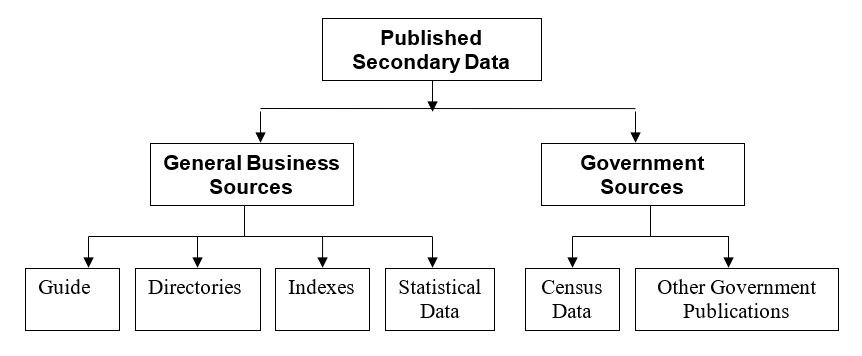

However, the researcher of this paper would concentrate more on the internet databases as this is an easy and less expensive system of secondary data collection, for instance, Emerald Journal is an excellent source, which properly analyzed the effect of ecotourism on the economy. In addition, it would use numerous articles from internet like Yasak’s “Development of Ecotourism in Malaysia”, Mohamed’s “The Development of Ecotourism in Malaysia—Is It Really Sustainable”, Recent Statistics, Hezri and Hasan’s article “Towards sustainable development-The evolution of environmental policy in Malaysia” and so on.
Limitations of the research
It has to face several challenges in order to organize this dissertation, for instance –
- As this is exploratory research paper, this dissertation is only based on secondary data, which is the first and foremost limitation of the paper. In this context, it is not possible to rely on primary data;
- This research paper has concentrated more on the descriptive research instead of quantitative or qualitative research approach. Therefore, it has to depend on the previous research; however, there are many available secondary resources, journal article and books those seem important apparently but practically many of these resources were backdated to use;
- However, short deadline for the completion of the research was another problem.
Findings and Discussion
Malaysian Tourism Industry Analysis & Position of Ecotourism
Daud (2000) represents that globally tourism and ecotourism has become increasingly large industry where new scope of business as well as investment reached at USD $ 350 million each year that represents approximately 7.30 % of aggregate global investments. Alternatively, more than 6.50 % of global workforce has employed in the ecotourism industry hence, increase in personal income, leisure time and enhance global transportation system as well as public awareness influenced global advance communication. Considering these facts, Mohamed (2002) illustrated that ecotourism and tourism is the second largest economic segment in Malaysia. However, tough global economic recession approximately 12.70 million foreign tourists visited Malaysia and earned revenue more than RM 24.0 billion in previous year where as ten years ago in 2000 this figure was only RM 7.00 billion. Moreover, compare to prior Malaysian tourism facts average growth of this industry was 9.26 % from 1981–2000. Meanwhile, WWF Malaysia assess that currently Malaysia earned RM 655.0 million every year from the ecotourism industry along with a significant growth in international arrival number as shown in flowing figure. For instance, during 1990 Malaysia recorded 54.0 % tourist arrival increaser growth where as in between 1997–98 tourism industry recovered with an increase of 53.0 % foreign tourist arrivals and continuing similar Economic Intelligence Unit (EIU) malice hold additional annual growth of 8.50 %.

Compare to neighbor ASEAN countries like Singapore, Indonesia, Thailand aforementioned figure represents significantly low but considering contribution on domestic economy, ecotourism as well as tourism in Malaysia has earned a dramatic flow of remittance.
Table 1: Foreign Tourist Arrivals in Malaysia from 1981–2001. Source: Mohamed (2002)
Concerning on competition among the ASEAN countries, Malaysia is rather enthusiastic to donate effort to making enhance as well as develop ecotourism products and services conveying new dimensions. By analyzing respective assessment of Malaysian ecotourism success it has obvious like other global competitors success of Malaysia grounded on number of international arrivals along with aggregate earnings from this industry. In recent time, definitely Malaysia is working for switching their key concentration on two aspects namely superior tourism quality and responsible foreign tourists. On another hand, in rare case, ecotourism success in Malaysia has assessed by observing low impact on environment and inversely proportionate success of the destination as well as conservation of natural resources. Historically, till 1990 Malaysian ecotourism industry was focus only traditional resorts where as at present wave of alternative ecotourism18 concept is spreading as heart of Malaysian ecotourism industry. More specifically, in order to flourish ecotourism industry globally Malaysia has occupied fifty-four protected areas covering 1000 hectares and in aggregate 1483 million hectares. Compare to domestic land areas total protected area of Malaysia is approximately 4.50 % including twenty-eight provinces’ nature covering 90070 hectares. Alternatively, amongst major national parks19 Kinabalu Park has recently positioned in the ranked of 630 global sites in accordance with the UNESCO’s World Heritage Site. At early 1939, gazette that Peninsular Malaysia was the biggest national park that covered 434351.0 hectares and in analyzing ecotourism industry, position significance of the Peninsular comprised major virgin forests of a variety of forest consisting altitudes with soils, but now it has about 0.740 million hectares of protected areas for natural resource conservation; however, following table shows recent facts-
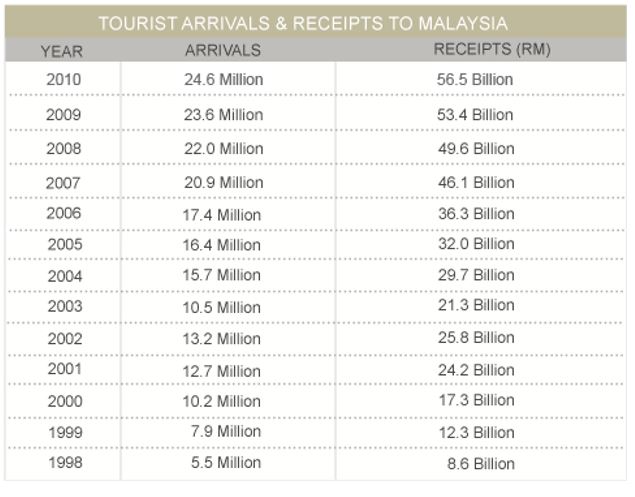
2nd World Ecotourism Conference 2010 in Malaysia
Chithra (2010) illustrated that the second World Ecotourism Conference (WEC) 2010 in Malaysia conveyed chief theme as urban ecotourism along with most responsible travel in the developing countries that included transforming standards as well as modernize strategies. Alternatively, few additional themes are included namely, i) market development of ecotourism ensuring satisfactory ROI (Return On Investment), ii) modern paradigms of urban as well as rural ecotourism, iii) structuring sustainable tourism roadmaps focus on turning green. Vision of the second WEC is to taking initiatives bringing major global ecotourism players to a common platform in order to networking, collaborating as well as sharing their valued experiences. Hence, structuring best ecotourism practices along with assess availability of modern technologies those would assist betterment of natural resource conservation as well as environment protection, community preservation programs and finally, superior progression of ecotourism globally. Conversely, core objectives of the second WEC 2010 is also pay key concentration on drawing roadmaps to supporting host countries those are eagerly in need of as well as await for a global platform. Moreover, numerous host countries are enough enthusiastic to be leveraged to champion, direct and support existing ecotourism policies for better position along with capable to take initiatives to make transformational changes to crafting respective national economic betterment as well as for their inhabitants and environment. Here point should to note that, the second WEC 2010 announced that individually each peer participant have scope to get reorganization for their contribution on collective intellectual as well as moral support which don’t comprise only profit making interests.
Malaysian Environmental Management
Hezri & Hasan (2006) structured that, within last five decades Malaysia accomplished vast socio–economic as well as environmental changes where rapid socio–economic progress accompanied through significant change in environmental resources. Conversely, in parallel to this progress government has also respond adapting emerging environmental circumstances proportionately. This part of the paper illustrated key environment management dynamics addressed by Federal Government of Malaysia to foster ecotourism industry as bellow.
- Federal Policy Formulation: concerning environmental issues, governmental responses, as well as key role has faced complexity in Constitutional Policy since every constituent state is enjoying certain independence by Law. Regarding this, during effective environment management Federal Policy has formed own forestry policy namely the NFC20 in 1971 and then the Protection of Wildlife Act 1972 (amended during 1976 and 1988). The wildlife Act is empowered managing wildlife reserves in the protected area with an attachment of DWNP21. Meanwhile, in 1974 EQA22 approved to focus on controlling pollution as well as provide a legal framework nationwide though following administrative innovations.
- The Ministry of Local Government and Housing 1975 administered the Division of the Environment
- Composition of advise minister with ten members of Environmental Quality Council
- Transformation of DOE23 in 1976 as MOSTE24
- Legislative Responses: Since 1980, the DWNP worked for protected areas for a secured energy supply.
- Regulations of Water Pollution and Reforming Water Sector: concerning on growing population load EQA 1974 amplified with numerous tasks namely, i) controlling noise pollution 1989, ii) scheduling toxic wastages 1989 and iii) controlling marine pollution 1993. On another hand, water sector has also reformed in 1998 with accompany of the National Water Resources Council that assigns to water service privatization and resolving interruption of public water supply.
- Assessing Environmental Impacts: the EIA formed in 1887 accompanying nineteen mandates focusing on ecological soundness.
- Strategies for Conservation: the WCS25 published in 1980 with the aid of three bodies26 and financed by WWFM27 though any of the strategies has not yet implemented.
- International Diplomacy:.as a chair of G77, Malaysia positioned in the third stage of environmental policy response like concepts of equitable sharing as well as response towards environmental challenges from 1989. Alternatively, appoint as chair of the CSD28, United Nations since 1993.
- Forestry and Biodiversity: Besides National Forestry Act 1993, comprehensive federal green policy worked for sustainable forestry and biodiversity.
- MS ISO 14001 and MS ISO 14004: two internationally recognized environmental management system focused on accountability of legal requirements as well as guidelines of industrial and manufacturing organizations, those have severe negative impact on natural resources (MSSC, 2007).
Excellence of Malaysian Ecotourism
In defining excellence of Malaysian ecotourism, it should to focus on some facts such as
- Mohamed (2002) concentrated on FEP during 1992 with additional materials as well as the Second State Tourism Master Plan in 1993 with SSTMP in 1996 29;
- He further added that in order to convey superior and value added services towards the firing arrivals, currently it has more than two thousand registered tour and travel agencies amongst them more than eight hundred are involved to taking booking for traveling nature based destinations;
- According to the government census, there have approximately thirty specialized companies for ecotourism and nature based traveling (Mohamed, 2002).
- In case of registered tour guides, Malaysia has more than 3500 guides, among them large number has full guiding licenses and relatively small number specific specialized skills. Most important attributes of aggregate Malaysian guides is that for every ecotourism function until now there have no detail breakdown of guides number as well as guiding skills. Moreover, in most field of ecotourism, there consists significant number of basic pool of resources where a group of specialized guides resumed international repute (Mohamed, 2002);
- Besides governmental ecotourism organizations, nongovernmental organizations are gradually increased their participation. Through Malaysia has not yet formalized ecotourism training courses but small number of trade organizations30 have started to provide training along with investigation of ecotourism quality (Mohamed, 2002);
- In assessing overseas tourist preferred sites Peninsular Malaysia, Sabah and Sarawak are most visited sites among twenty nature-based sites of Malaysia and in addition, these three are most popular for the local visitors also (Mohamed, 2002).
- Another assessment on Malaysian ecotourism revealed that about 7–10.0% of aggregate foreign visitors are engaged in ecotourism activities whereas more than 14.0% are expressed interest in walk, hike and trek but at the same time local visitors are engaged to guide, staffing and earning currency and considering this fact, every year 512000–1024000 foreign tourists visit in Malaysia. 31
Success Indicators of the Ecotourism Spots of Malaysia (314–18)
Bagul (2009) addressed that, greater number of ecotourism authorities agreed that to be succeed ecotourism industry should to promoting natural resources conservation as well as providing financial achievements for the hoist country along with their local people as well. Consequence of this, Malaysia as developing country has gradually move towards ecotourism earning high volume of foreign currency and simultaneously pay key concentration on preserving natural resources. Considering the issues, success indicators of the ecotourism spots of Malaysia segmented through four divisions namely, a) economy, b) culture, c) society and d) environment where ecotourism industry has significantly influenced through two ways like i) major objectives of the indicators and ii) respective quality attributes of the indicators. In another word, logic of ecotourism success is principally grounded two forces expectations and accomplishments. Hypothetically, accomplishment is a success indicator that either be positive or negative where positive accomplishment reflects best practices of ecotourism resources. In the light of four core ecotourism divisions, economy is an essential rationale if an ecological resource consists of economical value along with conserved attributes. For development that is more comprehensive it would be another significant part of conservation strategy for an effective policy formulation and action implementation with gradual support. Meanwhile, positive accomplishments are typically most preferred by the ecotourism stakeholders. Though in general, success indicators of ecotourism assessed through accomplishments of expectations, regarding this view following are the approaches of ecotourism success factors maximizing tourism benefits.
- Emphasis on accommodation venues32 along with food and beverage outlets and gradual improvement of their viability;
- Scope of earning additional revenue from local retail businesses as well as other business services33;
- Expansion of domestic and international markets for local products34 and key concentration on sustainable traditional customs as well as practices;
- Scope of employment of local labor and ecotourism expertise35
- Availability of funding for protecting and enhancement of enrich natural attractions along with symbols of cultural heritages.
- Available fund for engaging volunteers as well as researchers associated with fieldwork, wildlife and geological researches and archaeological studies.
- To restore the value of indigenous culture as well as natural resources gradually sharpen community awareness.
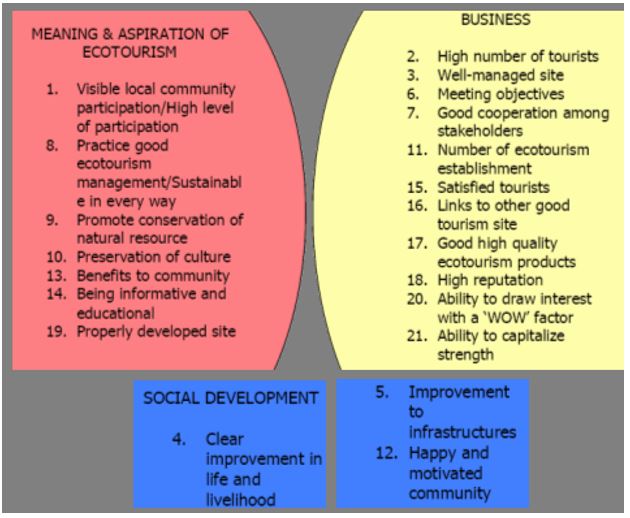
GDP Contribution from Ecotourism
According to WTTC (2011) report, latest ecotourism research 2010 on Malaysia find out that the industry has contributed USD $ 1770 billion directly to the global economy which is 3.30 % greater than prior fiscal year and moreover hope to make stronger further by 4.50 % amounted USD $ 1850 billion. Meanwhile, this vast contribution on global GDP would have made scope of direct industry jobs by additional three million people. Considering this intensified economic contribution, ecotourism then again would be contributed in the existing year USD $ 5987 billion to the global GDP with growth rate of 9.10 % along with 258 million jobs availability. Since ongoing global financial recession put together lots of impediments as well as challenges for both public and private industries, as a result significant numbers of developed economies seek to rescue from their greater debt volume. Alternatively, elevating price of oil along with supplement commodities still left hope for ecotourism to be the fastest growing sectors globally. In the meantime, emerging economies are expected to be positioned gradually as significant drivers of ecotourism growth by boosting scope of international travel as well as would have generated gradual vibrant to the domestic ecotourism industry. Considering all of the global facts, governments of major global regions recognized ecotourism as one of core pillar of economic growth. In the light of global overview, Malaysia being an ASEAN country has revealed an enrich figure on their ecotourism achievement where direct contribution from ecotourism grow by 5.10 % or in currency MYR 93.60 billion and expected to grow by 7.70 % within 2021. Moreover, at end of 2011 Malaysia hope to contribute directly MYR 56.90 billion that will equivalent 7.20 % of aggregate GDP. Regarding to this figure, Malaysian economic activity reflects that the respective ecotourism industry patronized thorough hotels, restaurants, travel agencies, leisure industries, airlines along with additional passenger transportation services. Thus Malaysian economy generate employment, assist and ensure sustainable development, lessening poverty ratio and spreading more equitable benefits across the entire population.
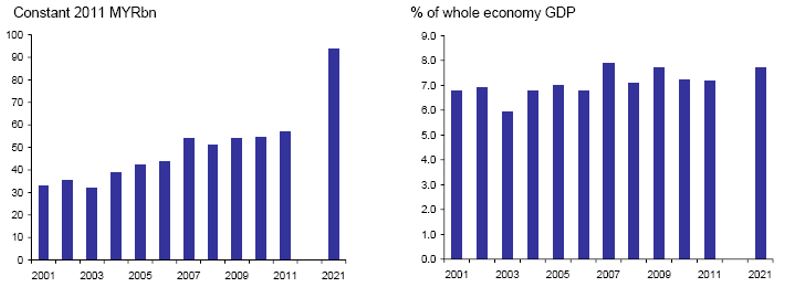
In another word, segmented contribution to GDP from ecotourism influenced aggregate investments, supply chain, and national income by MYR 124.70 billion at end of 2011 that will be 15.30 % of Malaysian GDP with an annual growth of 5.0 %. Consequently, Malaysia is hope to earn MYR 203.60 billion by 2021 16.80 % of total GDP.
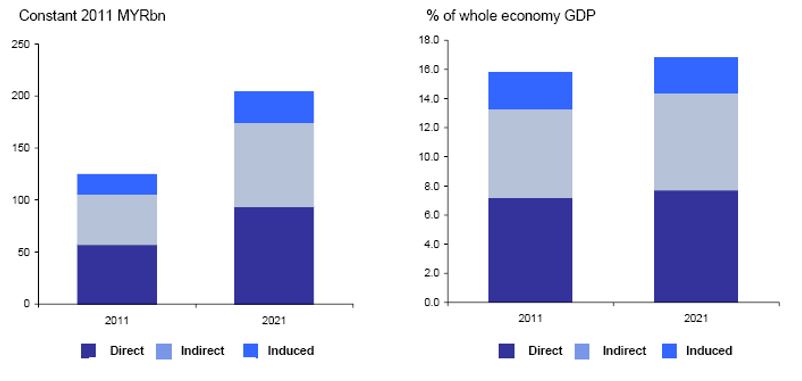
Community Involvement Indicators
WWF (2001) identified that, in the light of most authentic ecotourism definition focus on several aspects namely, responsible travel, environmental resource conservation and well being of the local people of host country. Regarding to the definition, the term community based ecotourism focuses on obligatory social dimensions to ecotourism. In another word, communality ecotourism engaged with the local community that attributed through i) substantial control, ii) involvement, iii) development as well as management, iv) competent crafting and allocating greater benefits amongst the community. Consequently, illustration of community involvement indicators are obligatorily required to grounded on both societal and institutional bodies. For instance, indigenous populaces are demonstrated collective right on lands as well as natural resources. Considering this view, community base ecotourism is therefore fostered sustainable utilization of collective responsibility. For a clear outline, following is the major indicators of community base ecotourism.
- As an ingredient of visitor’s experience, persist appreciations for nature along with indigenous cultures of prevailed natural areas.
- Make available education, training, and interpretation to the tourist offer.
- Assemble and organize small groups with an aid of small, specialized along with locally owned businesses even though there have foreign operators for trading and operating ecotourism.
- Gradually lessening negative impacts on both nature and socio− cultural atmosphere.
- Worked for protected natural areas by funding financial resources for the workers of restricted natural areas;
- Make scope of alternative income as well as employment for the local communities
- Make sharpen awareness of conservation of local and foreign visitors.
- Recreational along with special interest activities would also be an ingredient of community based ecotourism indicators36 because of attached with local knowledge, indigenous local income sources and high value on wildlife would reflected aggregate benefits.
Social Audit of Malaysian Ecotourism
To illustrate social audit on Malaysian ecotourism, Russell (1995) reported that social construction theory is most appropriate approach of describing social audit of Malaysian ecotourism. Regarding this view, both culture and history of the nation can be specified and construction of effective implications for conservation of environmental resources. Key motivation of social audit in this case is that use of ecotourism is a measure of positive nature experience that recovers exhaustion of the people of industrial society. Typically, ecotourism is an industry that engaged to make scope of traveling to natural areas to enjoy the environmental resources37 and conversely, for the host country an earning source along with tout causes of environmental woes because of industrial revolution. Then again, social audit on Malaysian ecotourism focus that in numerous case ecotourism are not perceived their valuable experiences precisely in accordance with the manner intended. Meanwhile, other than human being nature and animals have culturally as well as historically explicit and key feature is that they are not regard as innocent categories free from immune influences38 and additionally, implication of such immune issues deemed insignificant. Recent investigation on Malaysian culture and history, specified more understandable denotation on enrich animal varieties39 those surprisingly carried diversified culture, society, class and history.
Risk Factors and Concerned Challenges
Hernández & León (2007) focused that for regional and country development ecotourism is a potential alternative that requires strong natural base. Furthermore, sustainable ecotourism developed through compatible growth of tourist number along with ecologically valuable environmental resources preservation. In describing risk factors and concerned challenges, this part of the paper has concentrated on the correlation between two issues environmental degradation and impact on physical capital during managing natural resources as well as tourist products. Already, It has well-known that ecotourism consumer attraction patronized through implemented physical infrastructure on available natural resources which are also a great reason of negative influences on ecotourism products and services. On another hand, Malaysia is enriched with classical natural resources like minerals, tin, oil and natural gas and one of the major exporters of the tropical timber. Since colonial time mining and rubber plantation are two major source of Malaysian economic development where as from twentieth century rapid loss of valuable rain forest significantly linked with economic progress. In consistent with this forces, following are the risk factors as well as concerned challenges.
- Impacts on Waterways: Every year mining areas have released 16.26 million tones wastage into the river system of the Peninsular Malaysia;
- Clearing of Land: large scale of land for conversing forest is gradually taking place for rubber plantation as well as for agriculture. For instance, 11.0% of Peninsular Malaysia has grasped by accompanying roads and plantation development though FELDA40 converted more than 100,000 ha of forested land. On another hand, in early 80s decade Peninsular Malaysia had 9 million hectares of forested area or 68.0 % of total land area where as now it has 7.2 million hectares or in another word, 55.0 % of aggregate national land area. Alternatively, 3.40 million hectares are already logged left behind significant ecological impacts like high sediment loads, soil erosion of rivers in the logged areas. Furthermore, river system has also polluted through rubber effluents, palm oil mills and in addition, 90.0 % entire industrial pollution crippled local rivers;
- Increasing Deforestation: Though FELDA has awarded for successful implementation of rural policy but it lefts severe environmental impacts. However, controlling soil erosion as well as cultivating in the steep hilly areas has performed repeatedly. Conversely, though there have significant number of legal along with administrative measures to resolve deforesting since 1970 but from 80s to early 90s decade 230,000 hectares of land are already defroster due to agriculture and urban settlement.
Environmental Audit
Ahmad (2010) denoted that like another region of worlds, environmental audit in Malaysia is conducted to ensure improved environmental quality by means of better management of natural resources like air, water, waste management of solid and cleaner technology utilization. Moreover, environment audit effort is also worked for protecting as well as conserving land, water, biodiversity along with forest resources gradually in broader form. Concerning these facts, government of Malaysia has taken plan on preventive measures for mitigating as well as minimizing pollution of the country. In the meantime, government has aimed to promote and practice of sustainable natural resources41 management in more extensive form than prior. Alternatively, in doing so, government has constructed closer cooperation with local stakeholders as well as with the NGOs to address environment along with natural resources concern. Thus, government hope to enhance protection and conservation pf natural resources that would contribute improved as well as quality of life. On another hand, government’s environmental stewardship attached ensuring a balance among development needs, environmental management, and wastage management. Furthermore, greater focus has taken place featuring preventive measures mitigating negative impact on environmental resources, greater conservation effort, as well as sustainable natural resource management. In order to fostering environment audit, Malaysian government is engaged with EIA42, SEA43, CBA,44 and MBI45.
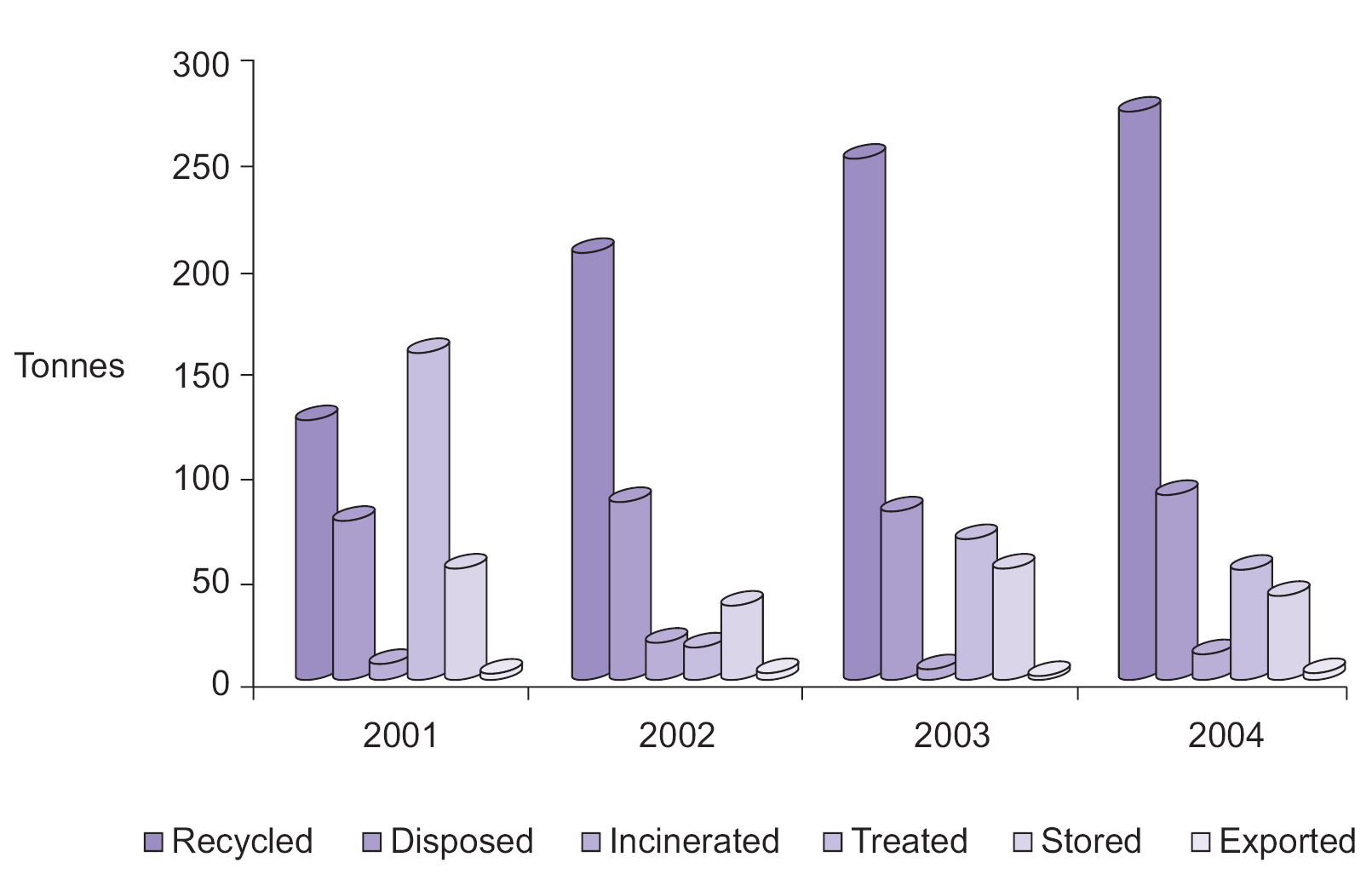
Sen’s Concept of Economic Growth of Third World by Human Development: Is Malaysia an Example?
In the literature review section, there has been a brief discussion about noble laureate Amartya Sen’s concept of economic growth of third world by human development. At this stage of chapter four, it is important to have an in-depth observation of how Amartya Sen’s concept of human development through fundamental freedoms, individual agency, human rights, skills and knowledge enhancement, and encouragement towards their empowerment have played significant roles in boosting the pace of economic development through ecotourism in a country like Malaysia. Subsequently, the paper shall focus on how, like Malaysia, other third world countries from around the world, for example, the highly prospective and magnificently beautiful ecotourism destination Bangladesh, or conspicuously pleasant Maldives can adopt Sen’s concept of human development to seek economic freedom.
As argued in the literature review, in past, economic growth was measured in terms of national GDP and poverty in terms of income-deficiency; significance was placed on economic-efficiency with no clear purpose of communal -freedoms, individual agency, and human rights; alternatively, Sen’s notion identified that market outcomes and government actions have to judge in terms of priceless human ends. Sen’s central thought lied behind the fact that the development and freedom of person, coupled with enhancement of their expertise, awareness, and more essentially, endorsement towards self-empowerment can be the best way to develop the “economy” (Prendergast, 2004). In his book “Development as Freedom” published in 1999, Amartya Sen stated that development must be observed as a procedure of intensifying the authentic freedoms which inhabitants enjoy; this extensive sight of progression was compared with the “extensively ubiquitous focus on the growth of actual earnings and on economic growth as the distinctiveness of flourishing development” (Sen, 1999). Sen never opposed to economic-prosperity being considered as a key aim of policy-generation, but he stated that it is merely a transitional objective, which contributes to individual’s living standards (Sen, 1997); moreover, in explaining how human development contributed to economic-prosperity, Sen (2002) draws attention to contribution of the pervasive access to education in the development of Japan, Korea, and Taiwan. In this context, when it comes to the perception of ecotourism and the acceleration of economic growth of third world countries, Sen’s concept of human development and empowerment becomes discernibly evident – because although ecotourism speeds up economic development, this becomes feasible only when the neighboring community near the ecotourism spot become involved with the development scheme through employment opportunities.
It has widely accepted that ecotourism had a great contribution in the economic development of Malaysia. In addition, as per Amartya Sen’s concept, such an economic development was not possible unless the ecotourism sector of the country was blessed with a rapid pace of human development. This human development has resulted as the government had expended more on the private sector firms (for example, firms working with either infrastructural enhancement, creation of more hotels and restaurants, or other forms of tourism based businesses) to encourage ecotourism by expanding their own businesses. Expansion of their own businesses mean recruitment of an increasing number of new workers from the local community of the ecotourism spot and training them up for developing their skills in order to empower them and make them independent in workplace. In addition, the government of the country had also expended greatly on the education sector.
This great level of human development achieved by the Malaysian government helped it a lot in the development of the economy by means of nature-based tourism – proving the pragmatic extent of Amartya Sen’s concept. In case of ecotourism, this human development becomes evident through local community-participation success rates in Malaysia. The following figure shows the way in which local community-participation success rates raised in Malaysia, that is, the indicators and sectors of communal participation and the parameters:
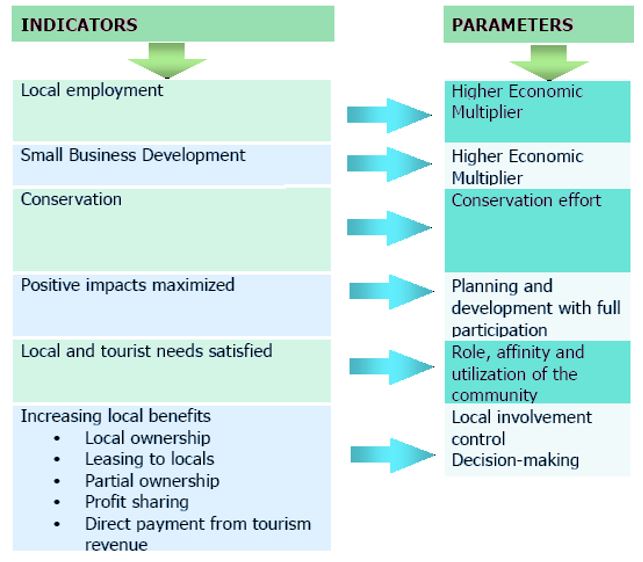
The following table shows the categorization of local community participation in different ecotourism sites of Malaysia, and the medium through which the local communities have engaged with development of the economy through ecotourism. Indeed, ensuring such a huge participation from the part of the local communities was not possible unless the government had focused sufficiently on human development projects:
Table 3: Categorization of community participation in ecotourism sites of Malaysia. Source: Self generated from Bagul (2009)
Applying Sen’s Concept to Boost Ecotourism in Prospective Third World Nations
It is no doubt that Sen’s human development approach can be the key to unlock the doorway of the superfluous stream of economic freedom. For those third world countries, which possess highly attractive tourism spots, economic development should arrive only when a path has created for letting it into – this path should be made up by huge expenditure on educational sector, training programs, social awareness building schemes (such as integrated marketing campaigns), and increased budget for higher education. If Sen’s model is trailed accordingly, a great prospect exists that following the footsteps of Malaysia, the other two developing countries of Asia, that is, Bangladesh and Maldives, find their economic freedom through this nature gifted business sector.
According to Iqball et al (2010), Bangladesh has great blessings of nature over it for being so beautiful. It is greatly prospective when it comes to ecotourism – because it has a lot more natural beauty than that of Malaysia, and if the government is able to promote this besides of developing Sen’s model, it can put Malaysia far behind and ultimately win the race of economic freedom. This is because whilst Malaysia has tourism spots only in a number of regions in the country, in Bangladesh, the whole country is an ecotourism destination. More importantly, it is arguable that recently, although Bangladesh has not achieved sufficient economic growth, it is achieving something that can be far more imperative – “human development”, or the main idea of Amartya Sen through which growth in third world can come by. In case of Bangladesh, as stated by Salam, Ross & Beveridge (2000), pace of the growth of human development is so fast that it is not far when the country will put behind the countries with the highest literacy rates, and surprisingly, this success is achieved not only at primary educational sectors, but also more rapidly, at the higher educational levels. As per Sen’s model, Bangladesh was able to put forward an amazingly well organized and extremely pragmatic higher edification system. In addition, its government has also undertaken various ecotourism projects to boost this sector. The most attractive ecotourism destinations include the following:
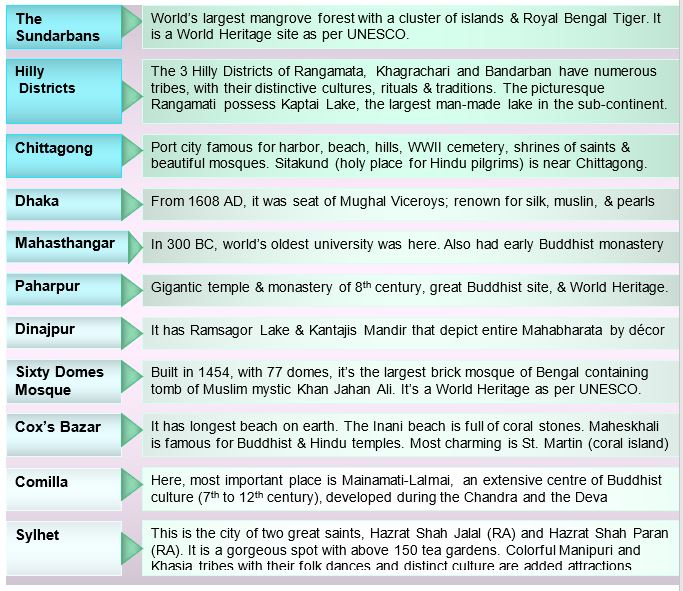
On the other hand, Gluckman (2007) argues that in case Maldives, the concept of ecotourism started developing as soon as a couple of decades later after its independence. Although it lacked sufficient infrastructure to support its ecology based tourism industry, but after long period of development process and expenditures as well as promotion from the part of the government, the industry started to get bigger. The resultant impact fell in the economy of the country in the form of rapid growth than any other third world countries in the same continent. However, this growth will start to slow down unless the government focuses more on human development through expending more on the education and training sector besides of the tourism industry. The following figure shows the ecotourism sites in Maldives:
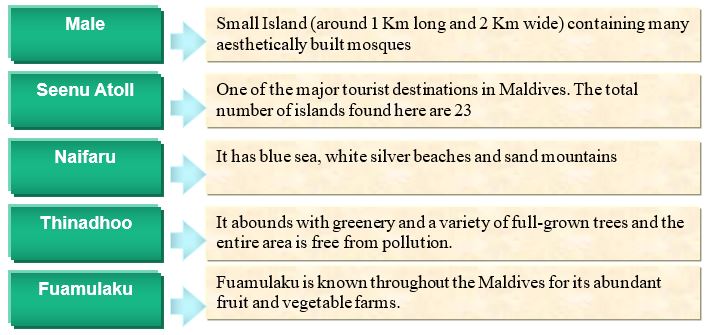
Conclusion
Recommendations
Impact of ecotourism in accelerating the economic development of Malaysia has been quite successful through which the country was able to boost not just the economic drivers like living standards of citizens or GDP per capita together with other factors like food security in terms of food availability, but also the fundamental freedoms of people, individual agency, and human rights. However, to ensure that the success in this industry remains intact for longer period, so that Malaysia can continue to earn foreign remittances, it is important to follow a number of models proposed in this section. Model 1 recommends emphasizing on safeguarding ecology and natural-areas, promoting ecological awareness amongst the neighboring inhabitants through enlightening them regarding the risks of wasting natural reserves, further encouraging ecologically secured local products/handicrafts/cultured therapeutic shrubbery to generate inhabitant’s entrepreneurial-skills; increasing community rights and management, and endorsing “feeling-of-pride” through stimulation or perpetuation of native customs and cultural-techniques:
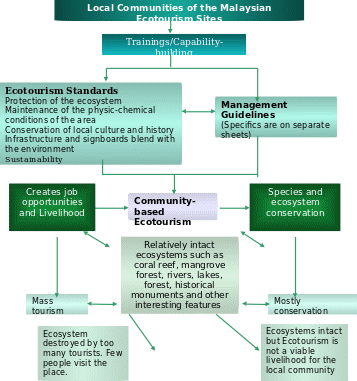
In addition, for ensuring sustainable preservation of natural beauty, which tends to be too fragile, Malaysian policy makers can follow the Model 2:
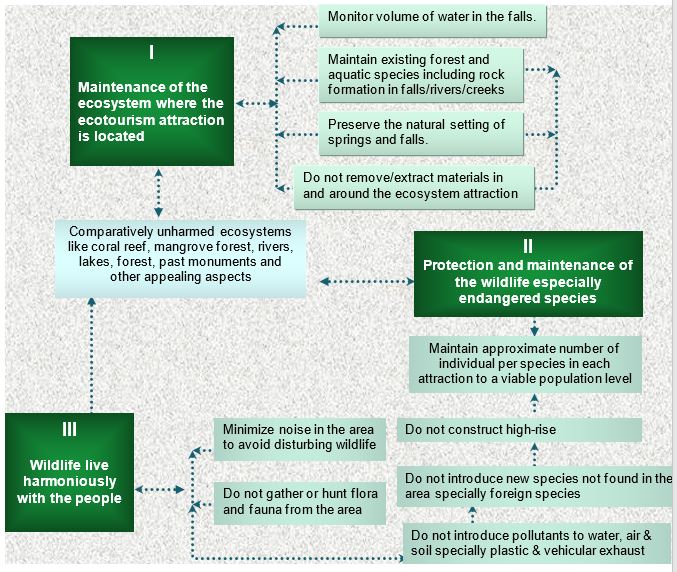
It is important to argue that although Malaysia has a strong infrastructural base upon which it is running a successful ecological tourism industry, the structural facilities still needs to be more submissive towards the atmosphere; therefore, the following Model would be useful:
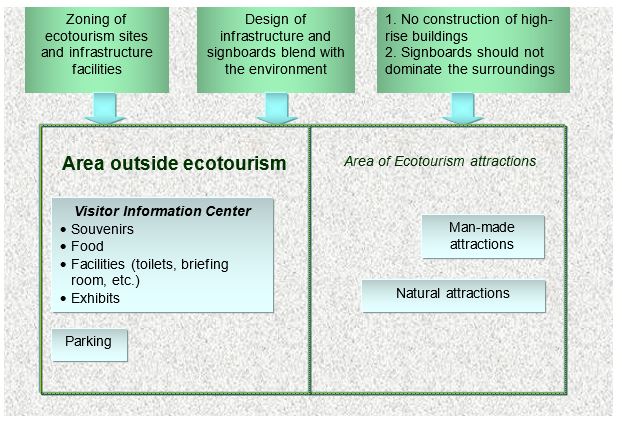
Conclusion
In conclusion, it is important to argue that ecotourism is a great way to accelerate the economic growth of third world countries. However, it is quite necessary that sufficient natural beauty and tourist attraction are present so that the country can earn significant revenues. As discussed throughout the paper, Malaysia is the most surprising example about the extent to which this sector can be beneficial to ensure economic freedom. Nevertheless, the Malaysian policy makers should seek to further boost the economic growth by focusing on the advancement of its infrastructure through integration of most modern technologies, and most importantly, through development of its human resources.
References
Afroze, R. (2011) Ecotourism and Green Productivity in Bangladesh. Web.
Ahmad, N. (2010) Promoting Environmental Stewardship. Web.
Bagul, A. H. B. P. (2009) Success of Ecotourism Sites and Local Community Participation in Sabah. Web.
Boerner. B. B. (2006) Stakeholders, Globalization, and Corporate Social Responsibility: A Look at International Ecotourism. Web.
Chaynee (2005) Benefits of Ecotourism for Local Communities. Web.
Chithra (2010) 2nd World Ecotourism Conference 2010’s (WEC2010), Malaysia. Web.
Commissioner of Law Revision (2006) Tourism Industry Act 1992. Web.
Daud, M. M., (2000) The Ecotourism Development in Malaysia. Web.
Denman, R. (2002) Product Development, Marketing, and Promotion of Ecotourism: Summary Report. Web.
EQUATIONS (2010) Community Involvement in Ecotourism in Madhya Pradesh. Web.
Gluckman, R. (2007) Paradise Maintained. Web.
Herdiyanto, F. (2008) Globalization and Ecotourism. Web.
Hernández, J. M. & León, C. J. (2007) Sustainable Environmental Degradation in Ecotourism Development. Web.
Hezri, A. A. & Hasan, M. N. (2006) Towards Sustainable Development? The evolution of environmental policy in Malaysia. Web.
Iqball, S., Salequzzaman, M., Haque, E., Islam, R., & Ahmed, S. (2010) Ecotourism in the Sundarbans and Its Surrounding – A Possible Sustainable Option for Alternative Livelihood Development. Bangladesh Research Publications Journal, 4(3). Web.
Jeffries, M. J. (1997) Biodiversity and Conservation. London: Routledge.
Malhotra, N. K. (2009) Marketing Research- An Applied Orientation. 5th ed. Prentice-Hall of India Private Limited.
Mohamed, B. (2002) The Development of Ecotourism in Malaysia—is it really Sustainable? Web.
MSSC (2007) Quality Management System, Environmental Management System & Safety and Health Protection. Web.
MWWG (1988) Malaysia Introduction. Web.
Neth, B (2008) Ecotourism as a Tool for Sustainable Rural Community Development and Natural Resource Management in the Tonle Sap Biosphere Reserve. Web.
ODI (2001) Economic Theory, Freedom, and Human Rights: The Work of Amartya Sen. Web.
Prendergast, R. (2004) Development and freedom. Journal of Economic Studies, 31(1): 39-56.
Raufflet, E. Berranger, A. & Gouin, J. F. (2008) Innovation in business-community partnerships: evaluating the impact of local enterprise and global investment models on poverty, bio-diversity and development. Web.
Regis, E. G. (2004) Conceptual Framework of Ecotourism. Web.
Rubinstein, W., Valdes-Fauli, M., Gould, K., & Khan, T. (2005) Ecotourism, Policy And Practice. Web.
Russell, C. L. (1995) The Social Construction of Orangutans: An Ecotourist Experience. Web.
Salam, M. A., Ross, L. G., & Beveridge, M. C. M. (2000) Eco-tourism to protect the reserve mangrove forest the Sundarbans and its flora and fauna. Web.
SATT (2011) Why Ecotourism is Important. Web.
Saunders, M., Thornhill, A. & Lewis., P. (2006) Research Methods for Business Students. 4th ed. London: FT Prentice Hall.
Sen, A. (1997) Resources, Values, and Development. Cambridge: Harvard University Press.
Sen, A. (1999) Development as Freedom. Oxford: Oxford University Press.
Sen, A. (2002) Rationality and Freedom. Cambridge: Harvard University Press.
Srinivas. H. (2011) Defining Eco-Tourism. Web.
Srinivas. H. (2011) Key Ecotourism Terms. Web.
TIEC (2000) Ecotourism Statistical Fact Sheet. Web.
Tourism Malaysia (2008) Recent Statistics. Web.
Varty. D. (2011) Ecotourism. Web.
Weaver, D. B. (2001) Ecotourism as Mass Tourism: Contradiction or Reality? Web.
WTTC (2011) Travel & Tourism Economic Impact Malaysia 2011. Web.
WWF (2001) Guidelines for Community-Based Ecotourism Development. Web.
Yin, R. K. (2002) Case Study Research: Design and Methods. 3rd ed. Beverly Hills, CA: Sage.
Footnotes
- Malays, Chinese, Indians and various indigenous people in Sabah & Sarawak
- Ringgit Malaysia
- Singapore, Japan & China
- Yasak
- Tourism Development Corporation of Malaysia
- Ministry of Culture and Tourism
- Ministry of Culture, Arts and Tourism
- Malaysia Tourism Promotion Board
- Small & Medium Scale Enterprise
- Mangroves, Mudflats, Nipa Swamps, Freshwater Swamp Forest, Peat Swamp Forest, Lakes, Oxbow Lakes, River Systems, Marshes & Wet Rice Paddies
- Forest Sanctuary for Wildlife, Virgin Jungle Reserve & Possibly Amenity Forest, Education Forest & Research Forest
-
- Protection Forest for soil and water conservation
- Commercial Forest for commercial exploitation
- Domestic Forest for local traditional use
- Amenity Forest for recreation, research, etc.
- Mangrove Forest subdivided for different uses
- Virgin Jungle Reserve for genetic conservation but often logged
- Wildlife Reserve
- Yasak
- Ministry of Culture, Arts & Tourism
- Either State Ministry or Tourism Executive Committee
- Parks, Forestry & Wildlife Departments
- Danish aid agency, DANCED & GTZ of Germany
- Eco, Agro & Nature Tourism
- Bako National Park, Crocker Range Park, Endau Rompin, Gunung Mulu National Park, Kenong Rimba Park, Kinabalu National Park, Kuala Gula Bird Sanctuary, Niah National Park, Rantau Abang Turtle Hatchery, Sepilok Orang Utan Sanctuary, Taman Negara & Tunku Abdul Rahman National Park.
- National Forestry Council
- Department of Wildlife and National Parks
- Environmental Quality Act
- Division of the Environment
- Ministry of Science, Technology and the Environment
- World Conservation Strategy
- World Conservation Union (IUCN), the Worldwide Fund for Nature & the United Nations Environment Programme (UNEP)
- Worldwide Fund for Nature Malaysia
- Commission of Sustainable Development
- Federal Ecotourism Policy (FEP) and Sabah State Tourism Master Plan (SSTMP)
- State, Regional & National
- Yasak
- Houses, Hotels, Motels, Guest Houses & Farm Stays
- Medical, Banking, Car Hire, Cottage Industries, Souvenir Shops & Tourist Attractions
- Locally Grown Produce, Artifacts & Value-Added Goods
- Eco−tour Guides, Retail Sales Assistants & Restaurant Table Waiting Staff
- Trail Walking, Photography, Hunting, Fishing & Participatory Conservation Programs
- Scenery, Animals & Plants
- Gender, Race, Nationality, Class or Sexuality
- Types of Categorization as Food, Pet or Feral & Influence of Art on Cattle Breeding
- Federal Land Development Authority
- Land, Water, Forest, Energy & Marine Resources
- Environmental Impact Assessments
- Strategic Environmental Assessments
- Cost Benefit Analysis
- Market Based Instruments